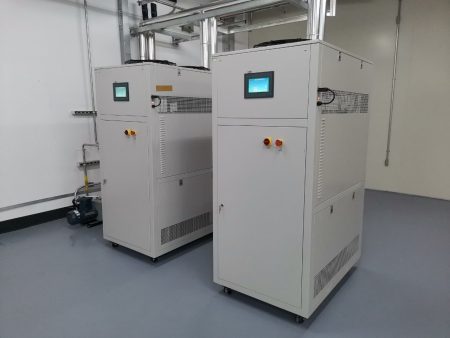Outdoor Water Cooled Chiller
完璧な温度制御ソリューションについては、今すぐお問い合わせください。
What is an outdoor water cooled chiller?
An outdoor water cooled chiller is one of those water chillers that removes heat from the water used in projects and industrial structures and puts the water back into the running cycle. In effect, a chiller moves heat from a space that requires temperature control to another space. Therefore, the chiller is not a means of generating cold, but a means of dissipating heat, whose task is to facilitate the transfer of unwanted and undesired heat caused by activity to places outside the system.
Cooling towers are specially designed for outdoor water cooled chillers. Because the condenser of a water-cooled chiller uses water as a stimulus and cooling material. The efficiency of a water-cooled chiller increases because wet surfaces are more successful at transferring heat and can do compression work at wetter temperatures.

How does outdoor water cooled chiller work?
Water-cooled chillers come into play during the evaporation process, the water and gas produced by the machine are taken to the evaporator and collect all the unwanted heat on the way and then return to the evaporator and store the obtained heat energy. After that, the refrigerant collects this heat and mobilizes it into the condensate, that is, the condenser sends all the collected heat to the cooling tower, and finally the hot air will pass through the cooling coil and dissipate the heat to the atmosphere.
The first stage:
The starting point of this cycle is where the water from the production process enters the evaporator and enters the cooling cycle.
During this part of the cycle, the heat absorbed by the refrigerant first appears in the form of a phase change from liquid to gas phase. As the refrigerant absorbs heat from the water, the temperature of the environment in contact with this part drops, so the water leaves at a lower temperature. This water enters the fan coil and carries the cool air to the desired space.
In fact, the evaporator is a place that, in addition to the current cycle, participates in another cycle, which is located between the evaporator and the water outlet of the cooling device. In fact, hot water enters the chiller evaporator, which cools it and then pumps it throughout the building to where it is needed.
second stage:
The gaseous refrigerant reaches the gas phase in the pre-liquid state and then enters the compressor. In the compressor, the gas condenses and the temperature and pressure increase so that it can enter the next high-pressure stage. The rise in pressure and temperature as it leaves the compressor is important because the refrigerant needs to release heat from inside the condenser, so it must carry enough heat to the condenser.
Another key function of the compressor is to draw refrigerant into the evaporator at the right time, keeping the pressure within the evaporator high enough to absorb the heat again.
The third phase:
The high-temperature gas enters the condenser, where the gaseous refrigerant is converted into a saturated, high-pressure liquid. This is a constant pressure process.
Since the condenser exists in another loop between the cooling towers, the water enters the cooling tower after the temperature rises. Because the main task of the cooling tower in a water-cooled chiller is to cool the consumed water, and the condenser uses this water as its driving material.
Where the excess heat of the water disappears and the water temperature returns to the desired low temperature. The heating process we mentioned earlier occurs in the condenser, releasing the gaseous refrigerant from the heat itself, which is the source of heat in question and needs to be eliminated by the cooling tower. In this way, the water entering the cooling tower from the condenser comes into contact with the air flow, transfers heat to the air, and then returns to the condenser.
The fourth stage:
The expansion valve is the last stage of the refrigerant and the refrigerant in the expansion valve undergoes these processes causing the refrigerant to become a mixture of liquid and gas and the same compounds re-enter the evaporator to resume the cycle.
Eメール info@lneya.com WeChat ID: +8615251628237 WhatsApp: +86 17851209193
 精密冷凍機/小型冷凍機
精密冷凍機/小型冷凍機
(カスタムデザイン)
チラーは様々な産業や研究所で広く使用することができ、カスタマイズされた設計をサポートしています。
| 温度範囲 | -18°C ~ +30°C | +5°C ~ +35°Cシリーズ | |||||||
| 冷却能力 | 0.35 ~ 0.9kW | 1.8~50kW | |||||||
| 注: -150℃の~ +350℃からの温度較差および冷却容量はカスタマイズすることができる | |||||||||

循環式チラー
(カスタムデザイン)
私達の再循環のスリラーは低温冷凍の技術を採用し、温度は- 120℃と低く、さまざまな付属品はカスタマイズ可能です。
| 温度範囲 | -25°C ~ +30°Cシリーズ | -45°C ~ +30°Cシリーズ | -60°C ~ -20°Cシリーズ | -80°C ~ -20°Cシリーズ | -120°C ~ -70°Cシリーズ | ||||
| 冷却能力 | 0.8 ~ 30kW | 0.75 ~ 12kW | 0.4 ~ 6kW | 0.2 ~ 6kW | 0.3 ~ 5kW | ||||
| 注: -150℃の~ +350℃からの温度較差および冷却容量はカスタマイズすることができる | |||||||||

低温チラー
(カスタムデザイン)
当社は、-150℃の温度制御範囲を持つ低温冷凍機の生産を専門としており、さまざまな業界の冷凍ニーズを満たすことができます。
| 温度範囲 | -25°C ~ -5°Cシリーズ | -45°C ~ -10°Cシリーズ | -60°C ~ -10°Cシリーズ | -80°C ~ -30°Cシリーズ | -110°C ~ -50°Cシリーズ | -150℃〜-110℃シリーズ | |||
| 冷却能力 | 12~360kW | 6~180kW | 6~180kW | 4〜180kW | 2~120kW | 2.5 ~ 11kW | |||
| 注: -150℃の~ +350℃からの温度較差および冷却容量はカスタマイズすることができる | |||||||||
(カスタムデザイン)
車両品質テスト用温度シミュレーション:バッテリー寿命テスト、燃料噴射装置/モーターテストベンチ、エアバッグテスト、コンポーネントテストベンチなど。

(カスタムデザイン)
電子部品の精密な温度制御に適しています。過酷な環境に対応する半導体電子部品の製造では、ICパッケージの組み立てやエンジニアリング、製造テストの段階で、電子温度テストやその他の環境テストシミュレーションが行われます。

バッテリーエネルギー貯蔵システム用液体冷却
(カスタムデザイン)
| 種類 | コンバーティング・ステーション用 | 蓄電池用 | 充電ステーション用 | ||||||
| 冷却能力 | 45kW | 5 ~ 8.5kW | 4kW | ||||||
| 注: -150℃の~ +350℃からの温度較差および冷却容量はカスタマイズすることができる | |||||||||

ZLFQシリーズ
(カスタムデザイン)
クーラント分配ユニット
液冷装置は、半導体試験、電子機器恒温試験、サーバー支持インフラ冷却、その他の流体温度制御場所に適しています。
| 温度範囲 | +5°C ~ +35°C | +5°C ~ +35°C | |||||||
| 冷却能力 | 15~150kW | 200~500kW | |||||||
| 注: -150℃の~ +350℃からの温度較差および冷却容量はカスタマイズすることができる | |||||||||

MDサーマルチャックシリーズ
(カスタムデザイン)
RFデバイスや高密度パワーデバイス(IGBTやMOSFET)のテストに使用され、実験用フラットパネル(プラズマ、生物学的製品、バッテリー)などの急速冷却にも使用できる。
| 温度範囲 | -75°C ~ +225°C | ||||||||
| 温度精度 | ±0.1℃ | ||||||||
| 注: -150℃の~ +350℃からの温度較差および冷却容量はカスタマイズすることができる | |||||||||

スクリュー冷凍機 (カスタムデザイン)
低温スクリュー冷凍機と常温スクリュー冷凍機
| 温度範囲 | +5°C ~ +30°C | +5°C ~ +30°C | +5°C ~ +30°C | +5°C ~ +30°C | -25°C ~ +5°C | -25°C ~ +5°C | |||
| 冷却能力 | 107~1027kW(シングルコンプレッサー) | 299~2134kW(デュアルコンプレッサー) | 98~934kW(シングルコンプレッサー) | 272~1940kW(デュアルコンプレッサー) | 48~467kW(シングルコンプレッサー) | 51~497kW(シングルコンプレッサー) | |||
| 注: -150℃の~ +350℃からの温度較差および冷却容量はカスタマイズすることができる | |||||||||
 LNEYA
LNEYA
 简体中文
简体中文



















































































